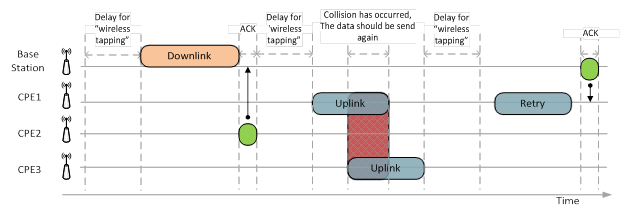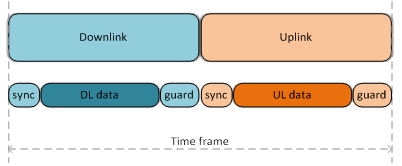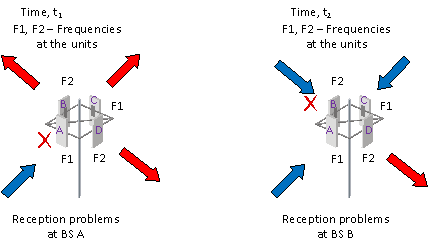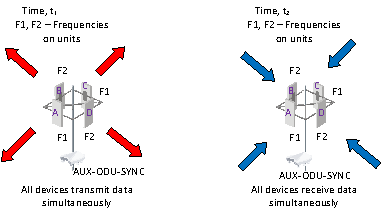...
| Center | |||||
|---|---|---|---|---|---|
|
Acknowledgement and retries process brings more reliability in general and decreases the amount of lost data. At the same time, such operation could create a problem in PtMP topology, because one “bad” subscriber with a lot of interference increase latency for all subscriber terminals, which don’t have any interference instead and could sent more traffic. In result, total throughput of the base station significantly depends from the existence of such “bad” subscriber terminals.
| Note | ||
|---|---|---|
| ||
Configuration of units in the marker access networks (Polling technology) should be done in accordance with recommendations from the documentation: Link Settings |
...
| Center | |||||
|---|---|---|---|---|---|
|
Unlike of Polling technology, TDMA provides synchronization between the base station and subscriber terminals.
Each device connected to the base station sector, synchronizes its clock in such a way so time on all devices within the same PtMP flows synchronously within the accuracy of microseconds. Hereafter, each communication session starts during fixed duration time intervals (time frames).
...
| Center | |||||
|---|---|---|---|---|---|
|
Sync – service information, required to maintain synchronization of the wireless link and ARQ mechanism operations. It has a fixed duration, which depends only on the current channel width. Sync doesn’t depend from the time frame size.
Guard – protective interval to prevent collisions occurrence. The duration of the protective interval depends only on the distance between units (approximately 3 ms for 1 km).
...
| Center | |||||
|---|---|---|---|---|---|
|
Mutual interference could be excluded, so all sectors would start to transmit and receive data simultaneously. By settings the same parameters for time frame duration and the same ratio for Uplink and Downlink – it is possible to have the same transmission and receiving time for all base station sectors.
Nevertheless, the same time frame size and even the same size for Uplink/Downlink does not guarantee the collisions absence. It is additionally extremely important to start transmission of all sectors and also to start transmission of all subscriber terminals at the same time. The internal clocks of every unit could differ from each other, thus the longer time interval we choose, the more significant the difference could be. TDMA technology includes synchronization of subscriber terminals time with the base station time, otherwise there will be big amount of collisions and retries in Downlink, and collisions could appear.
...
| Center | |||||
|---|---|---|---|---|---|
|
The external synchronization source allows time synchronization (every second start) on several devices (up to 7) with an accuracy less than one microsecond in such manner, that all connected devices would turn on the transmitters at the same moment of time. By doing this way – mutual interference of the neighboring sectors will be fully excluded. In either case single transmitting device by its powerful signal could interferes the other device to receive weak signals coming from the subscriber terminals. Synchronization unit (AUX-ODU-SYNC) has a built-in GPS/GLONASS receiver, and could be even used out of satellite access zone (for example, in the building). In this case, built-in clock generator works out ubiquitous clock pulse to all connected devices. However, it is required to eliminate inter-site interference (two independent base stations, located at some distance from each other), receiving of satellite signal is obligatory. This allows to use GNSS satellite signal as ubiquitous clock pulse.
AUX-ODU-SYNC parameters
- Compatibility with all base station sectors of InfiMAN 2x2 and InfiLINK 2x2 PRO
- Built-in GPS/GLONASS receiver and active antenna
- Provision of clock pulse signal via GNSS
- Provision of on site and inter-site synchronization
- Provision of geolocation information and universal coordinated time (UTC)
- 7 synchronization ports for sectors connection
...
| Center | |||||
|---|---|---|---|---|---|
|
Correct operation of the described above scheme require two following conditions to be present:
- Base station sector should not “hear” subscriber terminals of the other sectors
- Subscriber terminals should not “hear” signals of other sectors, except own sector signal
...
| Center | |||||
|---|---|---|---|---|---|
|
One of the solutions to solve the “bad” subscriber problem is to use TDMA technology. Even in case of high level of retries experiencing by one of subscribers, this particular subscriber will receive new (dedicated) time frame. Herewith the effectivity of other subscriber terminals throughput would be left intact, and consequentially the throughput of the whole wireless network won’t decrease.
SLA provision
TDMA technology allows operators to provide communication channels with guaranteed throughput for each subscriber terminal, ensuring correspondence to Service Level Agreement (SLA).
...
| Center | |||||||||||||
|---|---|---|---|---|---|---|---|---|---|---|---|---|---|
|
In case TDMA technology application, packets latency is stable and almost does not depends on the channel load (retries are not present). In case of retries, latency would increase because each retried packet would be sent in a new time frame and would occupy the same time as the original packet. However, this delay will not affect service of the subscribers who have no problems with data transmission.
Triple play PtMP
In case of demands in multiservice network provision, then selection of WBA solution will be probably the quickest and the most affordable way to provide the services.
...






